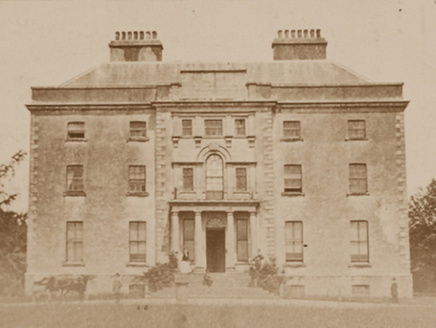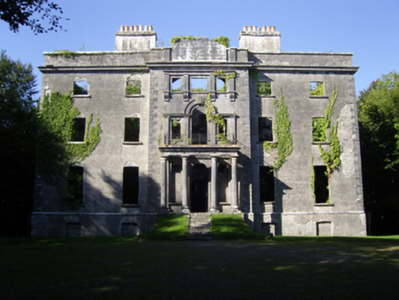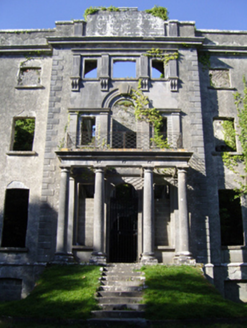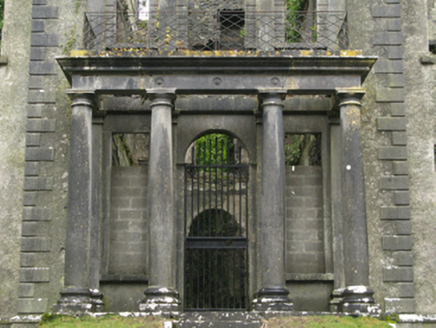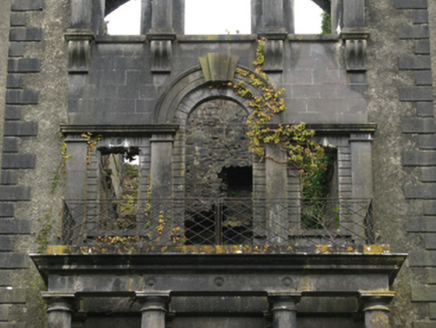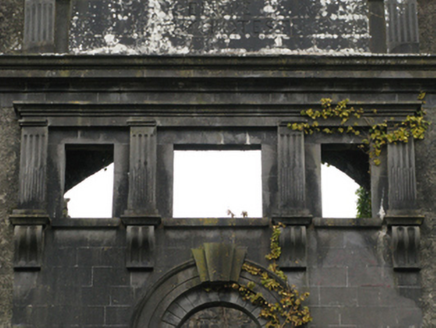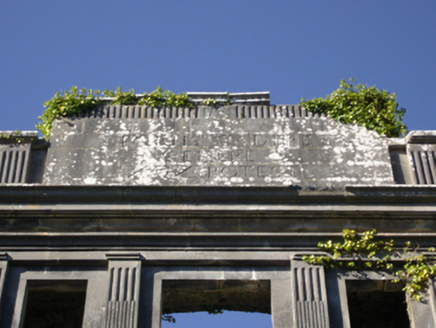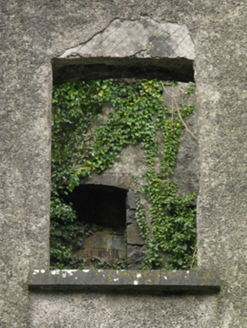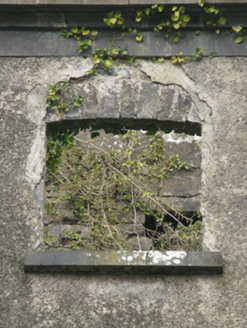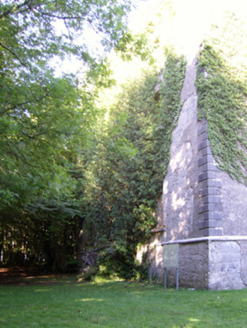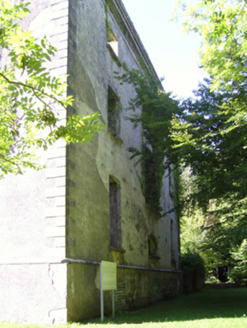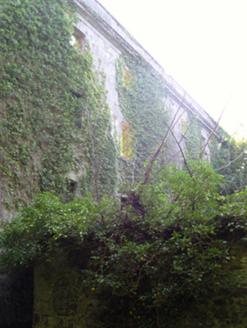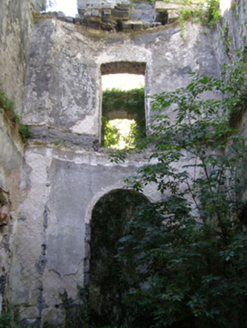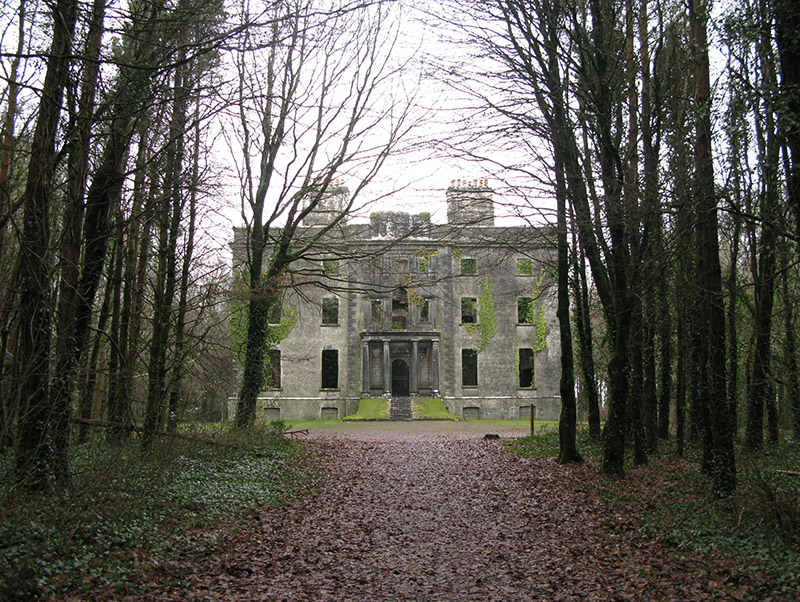Survey Data
Reg No
31310009
Rating
Regional
Categories of Special Interest
Architectural, Artistic, Historical, Scientific, Social, Technical
Original Use
Country house
Date
1790 - 1800
Coordinates
119078, 274425
Date Recorded
12/01/2011
Date Updated
--/--/--
Description
Detached five-bay (three-bay deep) three-storey over part raised basement country house, built 1792-5; dated 1795, on a symmetrical plan centred on single-bay full-height breakfront with prostyle tetrastyle Doric portico to ground floor; six-bay full-height rear (north) elevation. Occupied, 1901; 1911. Vacant, 1921. Burnt, 1923. Now in ruins. Hipped roof now missing with paired lichen-covered limestone ashlar central chimney stacks on axis with ridge having cut-limestone stringcourses below capping supporting terracotta or yellow terracotta octagonal pots. Part ivy-covered fine roughcast walls on lichen-covered tooled cut-limestone chamfered cushion course on fine roughcast base with drag edged rusticated cut-limestone quoins to corners including drag edged rusticated cut-limestone quoins to corners (breakfront) supporting dragged cut-limestone ogee-detailed cornice on blind frieze below parapet centred on inscribed dragged limestone ashlar "die" date stone ("1795"). Round-headed central door opening in tripartite arrangement behind prostyle tetrastyle Doric portico approached by flight of eleven benchmark-inscribed cut-limestone steps with dragged cut-ashlar columns having responsive pilasters supporting "Cavetto"-detailed cornice on roundel-detailed frieze below wrought iron parapet. "Venetian Window" (first floor) with drag edged dragged cut-limestone sills, and cut-limestone surround with pilasters supporting ogee-detailed cornice centred on archivolt. Square-headed window opening in tripartite arrangement (top floor) with drag edged dragged cut-limestone sills, and cut-limestone surround with stop fluted pilasters on fluted ogee consoles supporting "Cavetto" cornice. Square-headed window openings with drag edged dragged cut-limestone sills, and concealed cut-limestone voussoirs with no fittings surviving. Interior in ruins including (ground floor): bow-ended central hall with central door openings in segmental-headed recesses retaining decorative plasterwork "fan vaulted" overpanels, and rosette-detailed dentilated plasterwork cornice to ceiling. Set in wooded grounds.
Appraisal
A country house erected to designs attributed to John Roberts (1712-96) of Waterford (DIA) representing an important component of the late eighteenth-century domestic built heritage of County Mayo with the architectural value of the composition, one recalling the Roberts-designed Tyrone House (1779) in County Galway, confirmed by such attributes as the deliberate alignment maximising on panoramic vistas overlooking Lough Carra; the compact near-square plan form centred on a Classically-detailed tripartite breakfront carrying the Moore family motto ("FORTIS CADERE NON POTEST [A Brave Man May Fall But Cannot Yield]"); the definition of the principal floor as a slightly elevated "piano nobile"; the diminishing in scale of the openings on each floor producing a graduated visual impression; and the parapeted roof. Although reduced to ruins during "The Troubles" (1919-23), an act of vandalism recounted in detail in "The Moores of Moore Hall" (1939), the form and massing survive intact together with remnants of the original fabric, both to the exterior and to the interior including, remarkably, some decorative plasterwork enrichments highlighting the now-modest artistic potential of the composition. Furthermore, adjacent outbuildings (----); a polygonal walled garden (see 31310010); and the nearby "Grand Gate" (see 31310011), all continue to contribute positively to the group and setting values of an estate having historic connections with the Moore family including George Moore (1729-99); John Moore (1767-99), President of the Provisional Government of Connaught (fl. 1798); George Moore (1770-1840), author of "The History of the British Revolution of 1688-9" (1817); George Henry Moore MP (1810-70) of the short-lived Independent Irish Party (formed 1852; dissolved 1858); George Augustus Moore (1852-1933), author of "A Mummer's Wife" (1885), "A Drama in Muslin" (1886) and "Esther Waters" (1894) and assistant founder of the Irish Literary Theatre (1899); and Senator Colonel Maurice George Moore (1854-1939), 'Late First Battalion Connaught Rangers' (cf. 31310012).
